You have surely read about my last-time activities in Anti-Counterfeiting. If not then just search for "counterfeit" on my website here.
Of my many articles, I want to highlight a talk I gave 5 years ago, just before Covid-19 hit (click here).
In very short words, my prophecy became true. We now have means for tracking and tracing individual products worldwide, just by using your smartphone.
This is what I found in my local supermarket: a bottle of Balsamico de Modena vinegar from Italy. It carries this label:
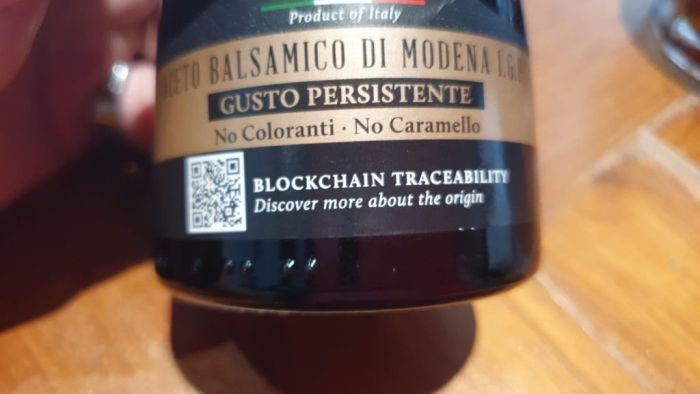
The wording "BLOCKCHAIN TRACEABILITY" caught my attention. I immediately bought that little bottle.
Here are more photos of the same bottle:
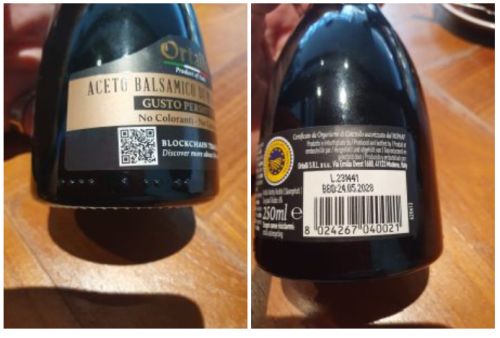
If you follow the URL of the QR code, you have everything that you need to find out more about the product: https://blockchain.ortalli.com/viewproduct/QR33
Follow the above link and you will see this field
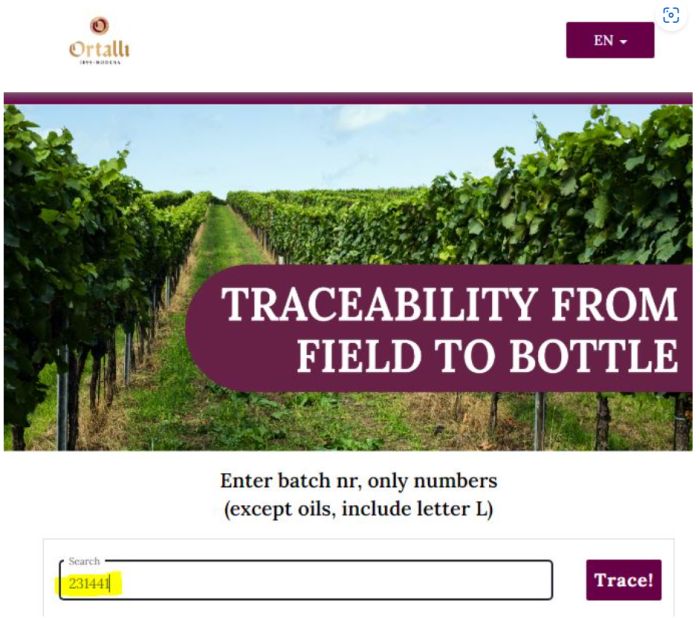
Then enter the lot number "231441" into the search field as shown above and press the "Trace!" button. This will show you the following history of the product, from harvesting the grapes until bottling the final vinegar:
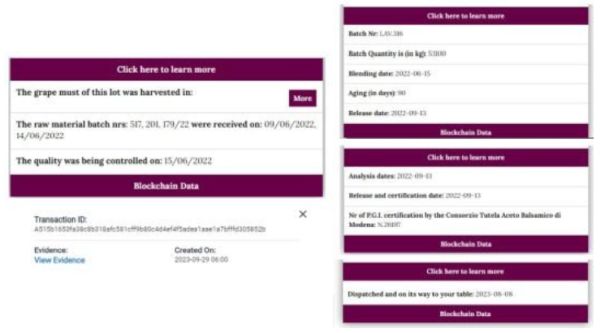
For those who want to know more, the technical data from the blockchain behind those events are readily available:
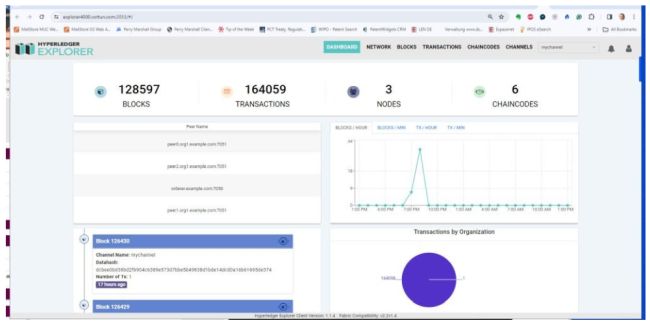
I was stunned upon seeing my vision of 2018 becoming alive right under my nose.
Data Analysis
Here is what I figured out from what I saw in the blockchain database entries:
1. There was a number of labels printed with the same lot number "231441" and and those labels have been put on the individual bottles of that lot before or on 24 May 2023, after which the bottles "ORT LV ABM 4F 12X1/4 V VIOLA ND" with the Balsamico vinagar have been dispatched out from the factory on 08 August 2023.
2. Before that bottling, a larger batch of Balsamico vinagre underwent a certification procedure by the Consorzio Tutela Aceto Balsamico de Modena on 13 September 2022, under the P.G.I. Certification number N.26197.
3. Before that certification, batch LAV.316 of 53.100kg raw vinagar was blended on 15 June 2022, followed by 90 days of aging in wood barrels, and finally released on 13 September 2022.
4. The grapes for making that raw vinagar were collected as material batches nrs 517, 201, 179/22. They were received at the factory on 09 June 2022 and 14 June 2022, followed by a quality control step on 15 June 2022.
5. The printed label with the lot number 231441 is linked with the bottles ORT LV ABM 4F 12X1/4 V VIOLA ND, with the P.G.I. Certification number N.26197, with the batch number LAV.316, and with the material batches nrs 517, 201, 179/22.
Assumptions and Shortcomings
I assume that one can say that if one finds a bottle with lot number 231441 that is in some aspects wrong, then one can deduce that there is some likelihood that other bottles from the same lot number also have a problem. That can help to promote product safety.
It can also be assumed that all bottles from the same lot number 231441 are rightfully certified under that P.G.I. Certification number N.26197. That serves as a quality feature of the product, and the company's marketing people used this in the case of my own Balsamico vinagar bottle.
The manufacturer could also run various A/B testing experiments, such as comparing the outcomes of different material batches or wine cask collections.
From a consumer and anti-counterfeiting professional's perspective, I see two shortcomings. The blockchain database does not show two important details:
- How did my Balsamico vinegar reach the supermarket in Singapore's heartland where I bought it? Was it shipped via airplane or ship? What were the stopovers that it made?
- What happened to my individual Balsamico vinegar bottle before I opened it? Was it bought by someone else and then re-filled with cheap vinegar before it was put back on the shelf?
Further Developments
It is very clear to me what needs to be done, and it is all outlined in my earlier talk: individualize the bottles, and collect location information together with time stamp information in the individual blockchain token for each bottle, as well as creating associated tokens for the boxes, for the pallets with the boxes, and for the freight containers with the pallets.
This is what I am seeing developing right under our noses: each single product gets a unique QR code applied to it, plus its packagings that are used while transporting that product from the manufacturer to the retailer or the customer.
What is new this year is a distributed database in the form of a blockchain ledger. The ledger serves to store the locations where the product or its packaging has been scanned by the parties that are involved in shipping the product. These updates of the shipment locations are protected against tampering by using hash encryption technology.
This results in a Distributed Global Shipping Repository (DGSR) that is accessible by anyone who is interested. Certain data of the DGSR, for example, prices or brand names of the goods, are only accessible for parties that have been authorized by the owner of the goods, for example, with a PIN code or with 2-step verification. That makes it possible to provide information that is only accessible for customs purposes and it protects the products from becoming prey for criminals while being shipped.
In a sideline only, the concept of having a DGSR that is accessible by anyone who is interested combines well with a recent development by the Singapore International Chamber of Commerce (SICC), which introduces an Electronic Certificate of Origin (eCO) based on Blockchain technology, see here and here.
Advantages
Many Advantages come with this technology, and manufacturers probably benefit the most from it:
- Product traceability improves the handling of customer complaints
- Product liability issues are more transparent
- Detection of grey imports (product diversion)
- Enforcement is easier at a local level as compared with border seizure
Customs Control Becomes Easier
Although this Science Fiction today, I can see it becoming reality soon: there will green lanes" for ISO containers that comply with the new standard. Comparing the bills of lading with then customs declarations and the actual content of the ISO containers in the green line" will be automated.
As a consequence, Customs can focus on the red lane" ISO containers. That is similar to what already happens at the arrival gates of airports.
This system incentivizes the shipping of containers according to the green lane" standard, and logistics providers have a good reason to charge more for accepting a shipping order for a "red lane" ISO container, which introduces some liability for them. I would expect more thorough due diligence from a logistics provider before accepting a shipping order for a "red line" ISO container.
As a side effect, erroneous border seizures also don't happen anymore. It would be a very embarrassing situation if this happened, as I can tell you from my own experience.
Counterfeit, Ethics, and Responsibility
By applying this new method, the responsibility for counterfeit products is shifted from the logistics provider to the retailers and consumers. Only they can tell whether the product that they are displaying or using is a genuine product or not. The manufacturers of the genuine products have enabled them to do so, by using modern technology. This is how it should be.
I don`t think that the new method of tracking the shipment locations of products will ultimately stop counterfeiting. I do anti-counterfeiting since 1996 and it is my personal experience that the majority of counterfeit products exist because consumers want them.
Download:
IP Lawyer Tools by Martin Schweiger
The content of this article is intended to provide a general guide to the subject matter. Specialist advice should be sought about your specific circumstances.

